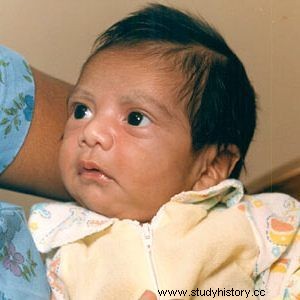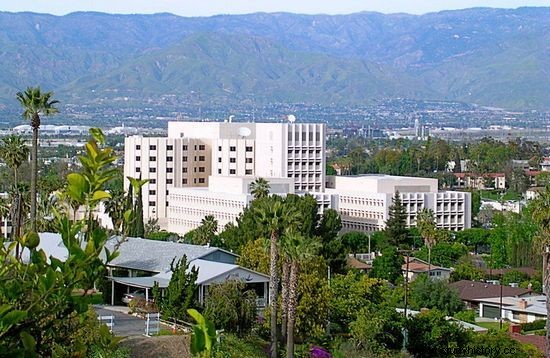In the age of stem cells and the development of artificial hearts, it is easy to forget that for decades doctors tried to implant organs from animals into humans. Neither of these experiments has been successful. The loudest and most controversial one came in October 1984.
Stephanie Fae Beauclair was born on October 14, 1984, with Left Heart Hypoplasia Syndrome - a congenital underdevelopment of the heart which, in her case, meant that the entire left half of the organ was essentially missing. This rare condition affects one child in 12,000. If left untreated, it leads to death within weeks.
In the 1980s, there were no confirmed therapies for hypoplasia syndrome. But little Stephanie's parents refused to give up. Under the influence of doctors from the hospital in Loma Linda, California, they decided to undergo ... the most risky surgery, which has always resulted in the patient's death.

Stephanie Fae Beauclair
Many commentators even assessed that it was sheer madness . The team led by Dr. Leonard Bailey decided to implant a baby with a heart taken from a young baboon.
A madman or a man of progress?
Dr. Bailey had dreamed of making a breakthrough in medicine for years. Until now, he had only experimented with animals, transplanting organs taken from others into one and watching how long it took for them to die. He was considered a pariah by much of the medical community.
Nobody wanted to publish his articles, and he managed to collect money for research only thanks to the kindness of his colleagues (who allocated part of their salaries to them). Nevertheless, he persuaded the parents of "Baby Fae" (initially the girl's real identity was unknown and the world media called her that way) to entrust him with their own child.
From the beginning, many signals pointed to inevitable failure. First, Bailey chose animals only somewhat similar to humans - having much smaller and slightly differently constructed hearts baboons.

Inhuman surgery. Dr. Bailey's team is transplanting a baboon heart to a little girl.
As he himself said in an interview with Time magazine, orangutans, chimpanzees and gorillas would probably be better donors, but he found it unethical or simply inconvenient to use protected species for transplantation (paperwork, protests by animal rights organizations, etc.).
Secondly, the girl's condition began to deteriorate rapidly before the doctors completed immunological tests to select the best donor. The baby had a rare blood group of 0, and the facility had only five baboons, which made the entire procedure difficult. Even so, Bailey, once gaining approval from his superiors for the experiment, was not going to let go.
The operation took four hours. The girl's new heart began to beat, and over the following days her condition gradually improved. Doctors emphasized that while she had difficulty breathing before, now she was behaving like a normal, healthy child:she wailed, cried, yawned and cuddled up to her mother. The reality, however, was not as rosy as it was presented by the transplant team.
First, the girl died twenty days after the operation. Never before or after has no human lived so long with an animal heart. At the same time, the transplant - contrary to expectations - did not extend her life. Without him, she would probably have died at a similar time. A lot of new controversy has also started to come to light.
An inhuman experiment?
Hospital officials enthusiastically stated that Sunday was perhaps the best day of her life . In fact - as reported by The New York Times - that day the girl was struggling to survive, while her body tolerated the animal organ worse and worse. The hospital concealed this episode.
Many doubts were also related to the parents' consent:did they really know what they were signing up for? Did they know the alternatives?
Dr. Moneim Fadali, a cardiac surgeon at the University of California, Los Angeles, commented hotly that the entire operation was merely an example of irresponsible bravado and for a child one had to look for a human heart, not an animal heart. Bailey replied that the chances of getting such an authority in the required time were minimal. In fact, his team didn't do anything about it. The most controversial was the information that on the day of the operation, another hospital told Loma Linda that he had a potential donor. The message was simply ignored.
The doubts do not end there. Baby Fae's parents opted for a risky procedure because doctors convinced them that there was no alternative for her. Not only did they condemn their child to unnecessary suffering, but also lost the chance to really help him. In fact, in 1984 the so-called Norwood surgeries were already performed (in a completely different hospital, of course). Medical details are not essential.

Loma Linda University Medical Center. It was in this hospital that Dr. Leonard L. Bailey performed surgery on little Stephanie (Source:Wikimedia Commons, Public Domain).
Suffice it to say that the procedure developed in the early 1980s by William Norwood, the head of cardiology at the Children's Hospital in Philadelphia, is the only confirmed treatment for the hypoplasia syndrome, which has a high chance of being completely cured.
In other words, instead of transplanting a baboon heart into your baby, you could really help him . As reported by Time, as early as 1984, 40% of children undergoing Norwood's surgery were saved. No wonder many commentators hailed Dr. Bailey's operation as an inhuman experiment .
The last such operation
The Loma Linda University website still reads that the operation on Baby Fae has contributed to medical progress and that dozens of children living with transplants are its enduring legacy. Well, that's a fine example of saving a face, because in fact, trying to transplant an animal heart into a human had only one result:abandoning such experiments. Since then, people have only been implanted with other people's hearts, and it is these children who managed to survive.
Stephen and Thomas Amidons, authors of the book “A genius machine. A biography of the heart, "they conclude: A team of surgeons have been accused of believing that the human body will adopt an organ from another mammal. Currently, most doctors treat xenotransplantology, or interspecific organ transplantation, as a plague and avoid it. Fortunately!
